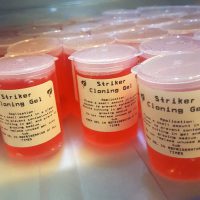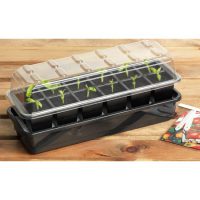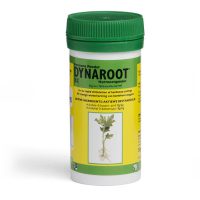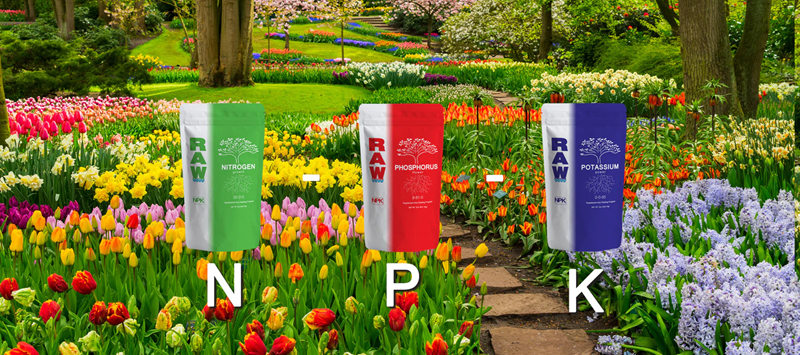Sowing Tray Without Holes
R65.00
In stock
Description
This multi-purpose Sowing Tray Without Holes can be used for cultivating microgreens and sprouting seeds in a range of grow medium. Ideal for placing multiple small seedling trays inside or can be used for water catchment for larger pots.
Size: 35cm x 48cm x 7cm
How to germinate seeds
Each type of seed has slightly different growing requirements, but the basics are the same:
- Use shallow containers (5 to 8cm deep) with drainage holes. It is easiest to monitor moisture in containers that are no more than 8cm deep and they require less growing medium!
- Use a lightweight seedling mix. These mixes are made primarily of ground peat moss or with coco coir as a base, and have sometimes been sterilized, so they are less apt to contain weed seeds, fungi, and bacteria that may hamper growth than garden soil. These mixes also provide good drainage, providing both the aeration and moisture seedlings need. Avoid using garden soil, as it won’t provide sufficient aeration and can introduce disease-causing organisms.
- Moisten the seedling mix before placing it in containers, like the Sowing Tray Without Holes. If you can squeeze a handful of the mix and water comes out, it is too wet and you’ll need to add more of the dry mix. The ideal moisture level feels like a well-wrung sponge.
- Fill the containers with moistened seedling mix to about 1.5 to 2.5cm below the rim of the container. Rap the container against the counter top to settle the mix.
- Follow the recommended planting depth on the seed packet when sowing seeds. This is generally 1-1/2 to 2 times the width of the seed. However some seeds need light to germinate and must be “surface sown” meaning they should simply pressed into the surface of the potting mix and not be covered at all; the seed packet will note if this is the case.
- Water seeds after planting using the mist setting on a spray bottle to avoid dislodging seeds with a strong stream of water. Check daily to make sure the mix is stays even moist, but not soggy. Seeds must stay moist in order to germinate properly.
- If the air in your room is very dry, you can maintain adequate moisture for germination by creating a tent over the pots or flats with clear plastic wrap. Prop the plastic wrap off the surface of the planting mix using Popsicle sticks or other ‘posts’ so seedlings don’t stick to it. Remove any coverings gradually as germination begins.
- Most seeds germinate best in warm conditions. Although average room temperature (21°C) is generally adequate for most seed germination, you’ll get faster and more consistent germination if you place newly seeded containers in a warm spot (21 to 26 degrees C) or on top of a heat mat (available from garden stores). With the right conditions, most garden seeds should germinate in 7 to 14 days (unless otherwise noted on the seed packet). Once seeds have germinated and produced their first set of true leaves (the very first you see are called seed leaves, and all that grow after that are true leaves), move containers of seedlings off the heat mats.
- Good light is essential. Once you see the first signs of germination, move the seed trays to a light-filled area. Seedlings need full sun from a south- or west-facing window or, even better, CFL lights positioned 5cm – 15cm above the foliage. Use a timer to keep fluorescent lights on for 12 to 16 hours a day. Suspend the light fixtures so that you can move them up as your plants grow, keeping them a consistent height above the tops of the seedlings. Leggy or pale green seedlings are an indication that plants need more light. If your seedlings are growing on a windowsill, rotate containers regularly to keep plants from reaching toward the light source.
- Keep the soil moist but never wet, as this encourages rot. At first, lightly mist the soil. Once seedlings emerge, place the containers in a tray and water from the bottom to encourage deep root development. Check daily and do not let the soil mix dry out.
- Wait to fertilize until the seedlings’ true leaves (the second set) appear. Then use a weak solution which will help the seedlings develop a strong root system.
- When seedlings have one to three sets of true leaves and are about 5cm tall, transplant them to a deeper container for growing on until planting time.
Get your Sowing Tray Without Holes today!











